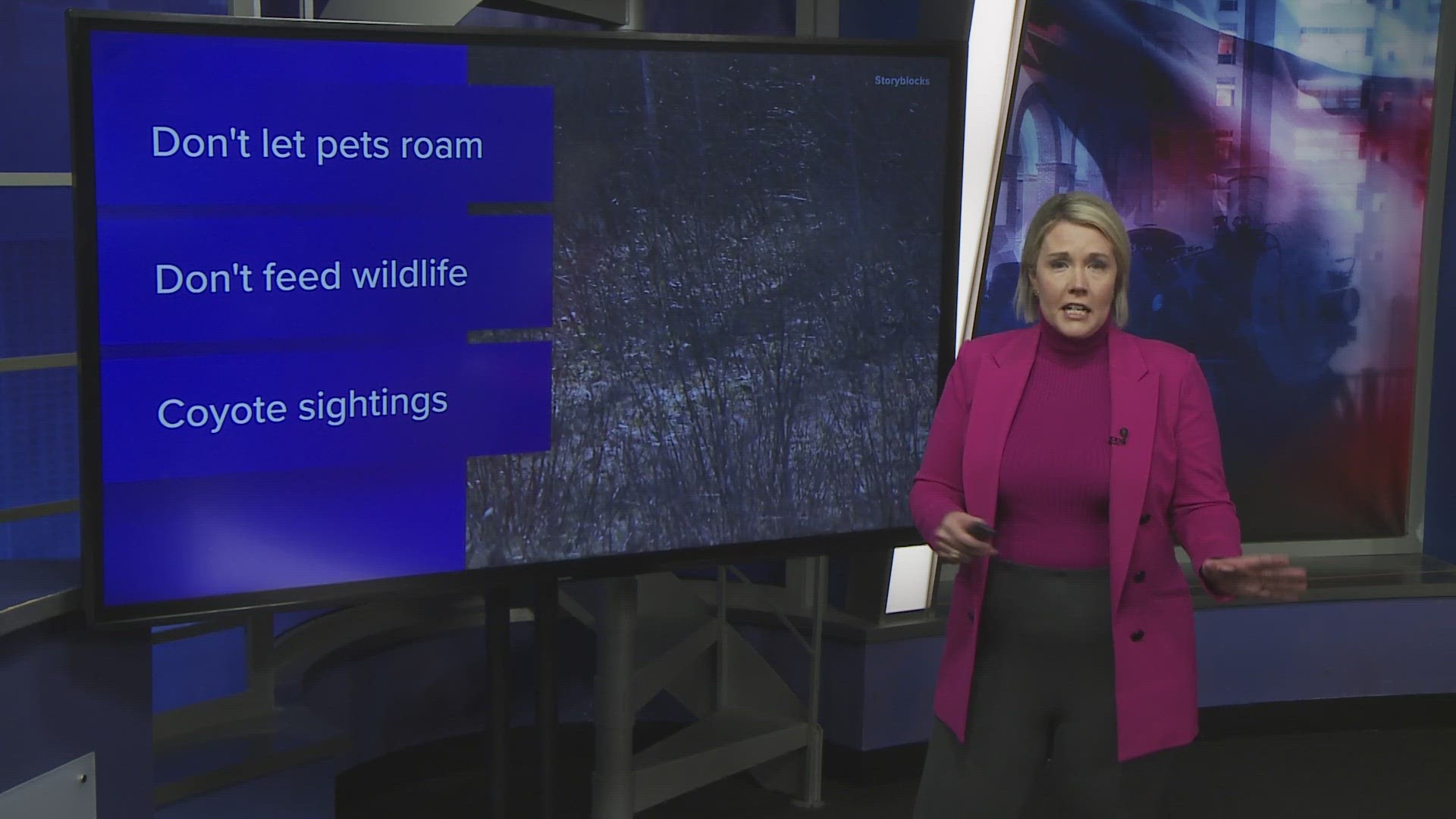TEMPLE, Texas — Coyotes are not an uncommon sight in many areas of Central Texas.
The Texas Parks and Wildlife Department (TPWD) says coyotes live among people in all urban areas of the state and are important predators that help keep animal populations in check.
Though coyotes typically avoid people, Texas Parks and Wildlife does have some tips for Central Texans on how to protect their pets during coyote mating season. Here is how you can keep both you and your furry friend safe.
Don't feed coyotes or other wildlife
One of the most effective ways to allow coyotes and people to coexist safely, according to Texas Parks and Wildlife, is to never feed wild animals, either intentionally or accidentally.
Texas Parks and Wildlife says to never feed coyotes directly, as feeding coyotes or other wild animals can result in the animals getting aggressive toward people or developing other dangerous behaviors.
As coyotes are "opportunistic omnivores", Texas Parks and Wildlife also advises Texans to avoid leaving out any potential food sources, or anything that could attract rodents for coyotes to prey on. Precautions include:
- Keeping pet food indoors
- Sweeping up fallen seeds under birdfeeders
- Picking up fallen fruit from trees
- Removing firewood or brush piles that could attract rodents
- Securing trash
Keep pets leashed or indoors
Texas Parks and Wildlife says pets that are allowed to roam freely face many threats and could end up going missing or getting injured, sick or killed.
Pets can be injured or killed while roaming freely by cars or other domestic animals, said Texas Parks and Wildlife, and could run into a hungry wild animal, such as a coyote, that does not make a distinction between pets and prey.
TPWD, as well as other organizations, recommend that pets are either kept inside where they are safe or kept on a leash.
Don't panic
TPWD reminds Texans that coyotes are found in cities across the state, and likewise residents should not be alarmed if they see one.
TPWD stated if a resident sees a coyote acting appropriately and non-aggressively, they do not need to do anything or be concerned.
Show coyotes they are not welcome
While TPWD said it is not necessary to interact with a coyote if one is seen, they said "hazing" a coyote, or showing it aggression if it frequents an area, could help to re-establish its fear of humans and discourage it from returning to an area.
TPWD said hazing could include:
- Making loud noises like clapping, yelling, blowing a whistle, hitting noisy objects together or using an air horn
- Waving hands, stomping feet or jumping
- Spraying water
- Throwing small objects at the animal with the intent to hit it
Watch for signs of aggression
Texas Parks and Wildlife tells residents to notify authorities if they encounter an aggressive coyote. They say aggressive behavior is not normal for coyotes and could mean they are unhealthy or habituated, meaning they have become so used to a certain stimulus in the environment that they are no longer affected by it.
If an aggressive coyote is encountered, residents should notify city authorities and Parks and Wildlife to document the incident and notify others in the area of any precautions that should be taken.
TPWD gave seven warning signs that a coyote has become habituated:
- An increase in observing coyotes on streets and in yards at night
- Coyotes approaching adults or taking pets at night
- Early morning and late afternoon daylight observances of coyotes on streets and in parks and yards
- Daylight observances of coyotes chasing or taking pets
- Attacking and taking pets on leashes or close to their owners, chasing joggers, bicyclists or other adults
- Being seen around children's play areas, school grounds or parks
- Acting aggressively towards adults in mid-day
TPWD says the habituation of coyotes should be documented by community leaders who are equipped to handle the situation. A well-structured reporting program can help community leaders to respond appropriately.
If there is a concern about coyote habituation, residents should report it to local leaders and include the following information:
- Time and date
- Where the sighting occurred
- What the coyote was doing
- How far they were from the coyote
- If the coyote saw them, and how it responded if so
- What actions they took and how the coyote responded
- If there were any pets or other animals nearby
TPWD says coyote attacks on people are extremely rare, and that they do not usually cause conflict.
TPWD said targeted lethal control is an option in some circumstances if recommended by wildlife professionals, but should only be handled by trained professionals who can trap the animals responsible for aggression.
Contact Texas Parks and Wildlife
Texas Parks and Wildlife said their department provides expertise and advice on urban wildlife issues but doesn't implement nuisance coyote control, though Texas Wildlife Services will provide services in partnership with local governments.
In cities such as Austin, Texas Cooperative Extension assists with coordinating nuisance coyote control and public education, said TPWD. To find the local office nearest to you, contact the main Texas Wildlife Services office at (210) 471-5451.
TPWD says urban and suburban coyotes are symptoms of a broader issue, similar to urban deer. As people continue to develop onto previously open-range wildlife habitats, it increases the chances of encounters or conflicts between people and wildlife.
Texas Parks and Wildlife says the solution for Texans is public education. They say Texans should be informed and empowered to take steps to coexist with coyotes and other urban wildlife.
More from 6 News:

